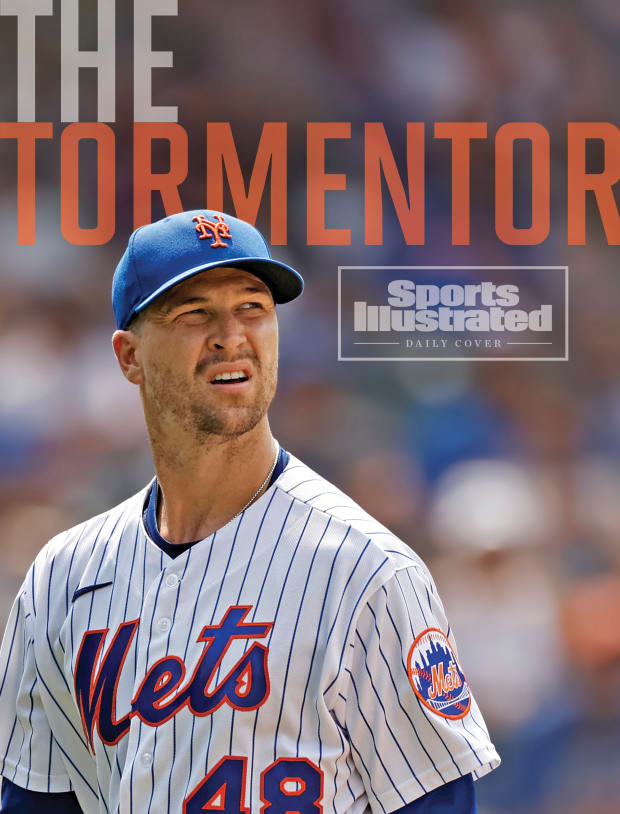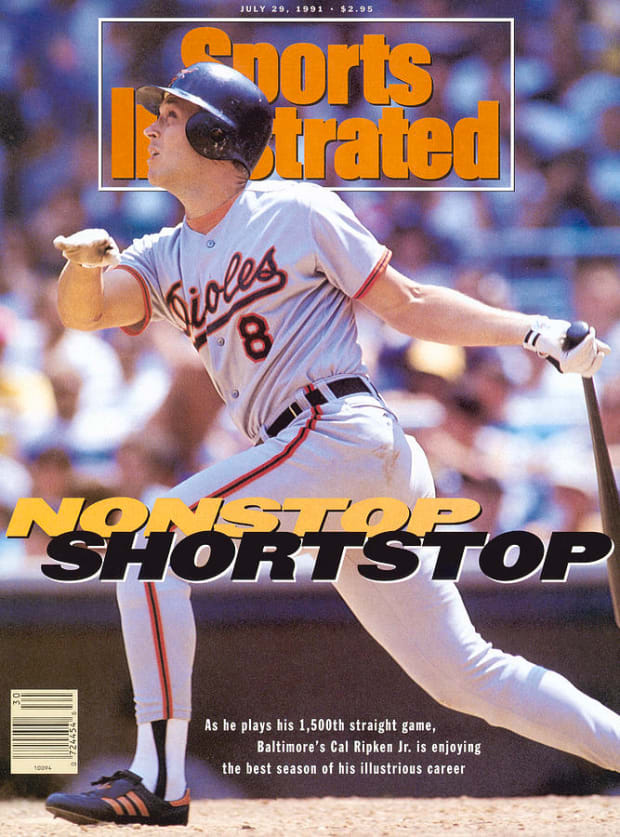Good morning, I’m Kevin Sweeney, pinch-hitting for Dan Gartland. The Mets are the second half’s must-watch team.
In today’s SI:AM:
⚾ How Jacob deGrom’s potential return impacts the Mets
🏈 A fizzled-out athlete organization effort at Penn State
📝 No more “homework clause” for Kyler
If you're reading this on SI.com, you can sign up to get this free newsletter in your inbox each weekday at SI.com/newsletters.
Inside the Mets’ Future with Jacob deGrom

The Mets may just be baseball’s most interesting team ahead of Tuesday’s MLB trade deadline. They have an owner willing to spend the big bucks, just swept their crosstown rival Yankees and already have one of baseball’s best pitchers in Max Scherzer.
They also have Jacob deGrom, perhaps the least predictable man in baseball … except when he’s on the mound mowing down opposing hitters. In today’s Daily Cover story, Stephanie Apstein takes you through all that’s complicated about deGrom. His clubhouse pranks could rise to the level of bullying, yet his closest teammates call him a “really good guy.” He was a workhorse earlier in his career, but will now go three straight seasons without throwing 100 innings. He’s committed to the Mets, but also seems likely to test free agency this offseason. As Apstein writes:
deGrom enjoys keeping people off balance, both at the plate and in the clubhouse. Sometimes he will ask new members of the organization startlingly personal questions, just to see how they react. “He’s testing you,” veterans explain.
There’s hope deGrom will return to a big league mound next week. If he does, another ace-level arm will be added to a Mets pitching staff that ranks second in the NL in ERA and third in strikeouts without him.
But there are no guarantees that things go smoothly. As Apstein notes, deGrom has dealt with a near-constant stream of injuries over the past 2 years. They’ve been the only thing capable of neutralizing his brilliance on the mound.
There’s also the fact that deGrom has barely been with the team this year. For a good portion of the season, he didn’t even have a locker at Citi Field. Manager Buck Showalter has joked that reporters who cover the team know deGrom better than he does.
All this complicates the outlook for the Mets in the season’s final two months and how the organization should strategize at the deadline. If they can count on a healthy deGrom, this team feels like it’s in World-Series-or-bust mode. deGrom can be a free agent in the offseason, while Edwin Díaz and Brandon Nimmo are also set to hit the open market. Scherzer isn’t getting any younger.
So is it time for Steve Cohen to push the chips in and make the big move? Could the Mets swing for Juan Soto and add an elite bat to the lineup? What about another trade with the Cubs like they made last summer, this time for Willson Contreras?
For now, I’m just excited to (hopefully) see deGrom on an MLB mound again. He’s not just an elite pitcher, he’s an elite athlete. And when he’s himself, he’s must-see TV on the mound. Before going down last season, he had one stretch in which he allowed one earned run and struck out 43 across three starts and another in which he didn’t allow a run for a month.
In the meantime, the Mets head to Miami for three games against the Marlins. You’re going to want to keep your eye on them as the trade deadline approaches. And if you’re interested to know just how much of a prankster deGrom can be, this piece is for you.
The best of Sports Illustrated
Richard Johnson broke down why an athlete organization effort at Penn State broke down and what it means for the future of college athlete unionization. … Emma Baccellieri highlighted each MLB contender’s biggest need at the trade deadline. … Albert Breer stopped by Pittsburgh on his training camp tour and is excited about the Steelers’ young wideouts. … Plus, Bob Harig caught up with Bryson DeChambeau at LIV Golf’s latest event and spoke to him about Tiger Woods’ vocal opposition to the new tour.
Around the sports world
The Cardinals dropped the “homework clause” in Kyler Murray’s new contract hours after Murray called the clause “disrespectful.” … The Juan Soto sweepstakes are on, and the Padres are rumored to be in the lead. … Sue Bird had 14 points and 7 assists, but the Sun beat the Storm in Bird’s final regular season game in Connecticut, where she once starred at UConn. … DK Metcalf got paid, reportedly signing a three-year extension worth $72 million with the Seahawks.
The top five...
… things I saw yesterday:
5. Cubs manager David Ross flipping … someone … the (double) bird.
4. Yet another Aaron Judge walk-off blast.
3. Tom Brady roasting Max Kellerman on Twitter.
2. This very fitting NIL deal.
1. Trey Mancini’s little league home run.
SIQ
How much money did a jury award the USFL when it ruled on this day in 1986 that the NFL had violated antitrust laws?
Yesterday’s SIQ: Other than Dennis Martínez, who is the only other pitcher born outside the United States to throw a perfect game?
Answer: Félix Hernández.
Martínez’s perfecto came in what was statistically his best season, at age 37. Pitching for the Expos that year, he led the majors with a career-best 2.39 ERA and recorded an MLB-best five complete-game shutouts. But, likely because he went 14–11 for a Montreal team that lost 90 games in an era where awards voters cared about pitcher wins, he only finished fifth in Cy Young voting. (Tom Glavine, who had a 20–11 record and 2.55 ERA, won.)
We’re quickly approaching the 10th anniversary of Hernández’s perfect game, which was thrown on Aug. 15, 2012, and remains the most recent perfect game in MLB. The 10-year gap is the longest stretch between perfect games since the 13-year drought between Catfish Hunter’s (May 8, 1968) and Len Barker’s (May 15, 1981).
From the Vault: July 29, 19

Ronald C. Modra/Sports Illustrated
The 1991 season was the best of Cal Ripken Jr.’s career. Though he had won the MVP as a 22-year-old in ’83, his second big league season, while leading the majors in hits and doubles, he was even better at the plate in ’91. Ripken batted .323 with a .940 OPS, 34 homers and 114 RBIs. He also led the majors with 368 total bases.
About midway through that season, he landed on the cover of Sports Illustrated with a cover story by Tim Kurkjian, who wrote that Ripken was “a candidate for MVP even though the Orioles are in sixth place in the American League East.” Ripken did end up winning the award even though Baltimore finished with the third-worst record in the majors.
Ripken’s MVP season came on the heels of a disappointing 1990, when he batted .250 with a .756 OPS. That down year made him want to work especially hard during the offseason to fix whatever what holding him back, Kurkjian wrote:
After last year, when he batted only .250, Ripken analyzed his swing, his approach, everything, and worked maniacally in the off-season to improve. “He was on a mission,” says Flanagan. Ripken says, “I got away last year from what made me successful. I looked in the mirror and asked, ‘Is my talent dwindling?’ Instead of thinking that you’re going to have a long career, you’re doubting yourself, worrying. This year I’ve gotten things more in focus, and it’s taken away any doubts.”
You’ll read a paragraph like that in every article about an athlete having a good year, but Kurkjian includes several other anecdotes about Ripken’s unrelenting work ethic, like how he would go all-out in pickup basketball games during the winter at a Baltimore high school:
No fans were watching, there was no image to uphold and no iron man streak on the line, but every game at Bryn Mawr was like the seventh game of the World Series to Ripken. He was a madman on the offensive and defensive boards. He dived for loose balls. If the big man he was guarding was slow getting down the floor, Ripken harassed the little guard bringing the ball up. In basketball as in baseball, Ripken isn’t a marvelously skilled or graceful player, but he was the best at Bryn Mawr. Ripken was so dominating that new players—all big—were recruited to guard him and make the games fairer. He pounded them, too.
Ripken’s “no days off” attitude was quite literal, of course. Kurkjian’s article was published right after the shortstop played his 1,500th consecutive game. He was still more than 600 games away from Lou Gehrig’s record but the streak was already a major talking point:
“He’s the only man in baseball who could do it,” says Seattle second baseman Harold Reynolds. “He’s a stud.” Ripken is 629 consecutive games away from breaking a record (2,130, by Lou Gehrig) that was believed to be unapproachable. But he had to defend the streak last year to Orioles fans who looked at his batting average (.256) from 1987 to ’90 and claimed he was tired. In this era, when players are constantly missing games with injuries, the fans should have been carrying him off the field on their shoulders.
Kurkjian’s story also questions whether Ripken would be considered the best player in Orioles history and whether he would rank among the five best shortstops ever. By the time he retired 10 years later, the answer to the first question was obvious. As for the second, that’s more of a debate.
Check out more of SI’s archives and historic images at vault.si.com.




!["[T]he First and Fifth Amendments Require ICE to Provide Information About the Whereabouts of a Detained Person"](https://images.inkl.com/s3/publisher/cover/212/reason-cover.png?w=600)


